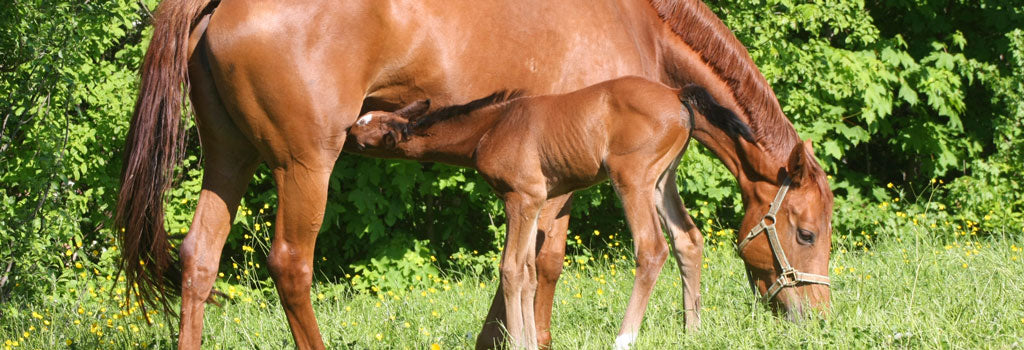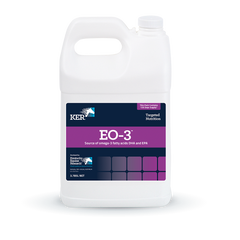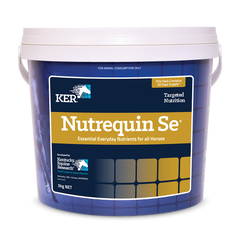Breeding

When it comes to breeding horses—renowned for their conservative pregnancy rates compared with other domestic animals—all the cards should be stacked in the horse's favour.
Broodmares
The nutritional status of mares is a critical component in foal health from the moment of conception and continues through weaning.
The most common mistakes are overfeeding during early pregnancy and underfeeding during lactation. The breeder should aim to maintain the mare in optimum condition throughout the year by monitoring body condition and weight. This the best way of ensuring correct development and growth of the foal and the nutritional health of the mare.
Mares should be kept in moderate body condition, so the amount of supplementary feed will depend on the available pasture as well as the individual’s caloric needs. Feed mares according to their individual requirements. Be aware of differences in caloric requirements (or differences in efficiency) between breeds, understand and compensate for seasonal effects on pasture quality and quantity, and make condition scoring of mares a routine management task, acting on the slightest noticeable changes with the aim of always keeping the mare in a desirable body condition.
Finally, ensure mares receive optimal intake of nutrients during the last trimester of pregnancy in order to support the most rapid phase of fetal growth as well as to supply the trace minerals the foal will store in its liver for use during the first few months of life.
Various aspects of pregnancy and foaling can be supported and, in some cases, improved through specific nutritional support. The antioxidant vitamin E has been shown to support improved fertility in mares that have trouble conceiving. In addition to benefits from feeding a natural-source liquid vitamin E, DHA and EPA fatty acid supplementation from fish oil has been shown to decrease the incidence of abortion, improve colostrum quality, and enhance passive transfer of antibodies to foals.
Breeding Stallions
Breeding stallions require a carefully balanced diet to maintain optimal body condition and fertility. For the stallion, the year can be divided into two basic phases, the breeding season and the off-season. The breeding season lasts approximately five months for the majority of stallions, but may double when stallions stand for breeding seasons in both hemispheres. Regardless of the number of mares bred, stallions must be properly nourished to perform their jobs successfully.
Stallions are sometimes expected to be fertile with normal sperm counts all year, every year. However, as with the mare, the fertility in the stallion varies according to the season. The sperm count (concentration of sperm per ejaculate) is lower in late autumn and winter, being only about half of that in spring and summer. The total semen volume is lower in winter, and a stallion is much slower to mate (less interested) in late autumn and winter, and is also more likely not to ejaculate even when he does serve a mare.
From a nutritional standpoint, the act of breeding can loosely be classified as work. Breeding stallions expend nearly the same amount of energy as performance horses in light work. However, a stallion’s caloric expenditure may be elevated when bred multiple times a day and in stallions that naturally give themselves more exercise, such as those that display nervous behaviours. Additionally, some stallions continue to be in work either competing or simply being exercised, and the caloric expenditure is additive to that of breeding. Stallions should be maintained on diets designed to provide the recommended intake of forage and satisfy their caloric needs and nutrient requirements. The stallion’s diet should provide the appropriate amount of calories to maintain the horse in optimal condition, avoiding excessive thinness or obesity.
Certain aspects of stallion reproduction have been shown to be improved by supplementation. In order to survive and achieve fertilization of the egg, the sperm cell must survive some harsh conditions, from freezing and thawing in the case of shipped semen, to the mare’s body and its defences. For that reason, antioxidant protection is key when attempting to improve the chances for a successful mating. Vitamin E is an essential component of body-wide antioxidant defences and plays a vital role in reproductive functions. Supplementation with high levels of vitamins E and C, individually or together, has resulted in increased sperm output, concentration, and motility while decreasing numbers of dead or abnormal sperm in a number of species.
Semen contains significant amounts of fatty acids, mainly of the omega-3 and omega-6 types, as these are incorporated into the sperm cell membranes. These components are important in sperm motility, sensitivity to cold shock, and fertilization capacity. Because grain diets for horses are typically considerably higher in omega-6 fatty acids, it was thought that supplementing with omega-3 fatty acids might improve semen quality. A study at Texas A&M University showed that stallions supplemented with omega-3 fatty acids showed a threefold increase in semen levels of omega-3 fatty acids and an improved semen ratio of omega-3 to omega-6.
Benefits of EPA and DHA supplementation in stallions included increases in total motility, progressive motility, and rapid motility of sperm. Similar studies at other locations resulted in improved total numbers, morphology, and percentages of live sperm in supplemented stallions.
Which Solution Is Right for Your Horse?
EO-3™ Concentrated direct source of DHA and EPA omega-3 fatty acids. EO-3 is a rich source of the long-chain omega-3 fatty acids DHA and EPA in a palatable liquid form. EO-3 can be fed to all classes of horses including foals, breeding stock, and performance horses to improve the critical ratio of omega-3 to omega-6 fatty acids in the diet.
Nano-E® Liquid natural-source vitamin E with superior bioavailability. Nano-E is a revolutionary natural-source vitamin E supplement for horses. Liposome encapsulation and nanodispersion ensures rapid and superior bioavailability for all horses.
Nutrequin Se® Essential everyday nutrients for all horses. Nutrequin Se is an exceptional value-for-money vitamin, mineral, essential amino acid, and antioxidant formula, specifically designed to supplement horses on home-mixed diets or those consuming forage-only diets.
Gold Pellet® The ultimate vitamin, mineral and amino acid supplement for horses. Gold Pellet has been scientifically formulated to contain essential nutrient levels to meet requirements for work or growth, and is designed to complement a traditional diet of grains and roughage.
Learn More
- Monitor Broodmare Health for Breeding Success
- Six Steps to Feeding a Pregnant Mare
- Q&A: Feeding the Easy-Keeper Broodmare
- Broodmare Nutrition: Advantages of Feeding Omega-3s
- Conception Failure in Mares: Seven Causes
- Cushing's and Age-Related Decline in Equine Reproductive Efficiency
- Breeding Stallions: Nutrition Matters
- Stallions: Are Breeding and Showing Mutually Exclusive?
- Stallion Health: Dual-Hemisphere Breeding
- Benefits of Omega-3s for Stallions








